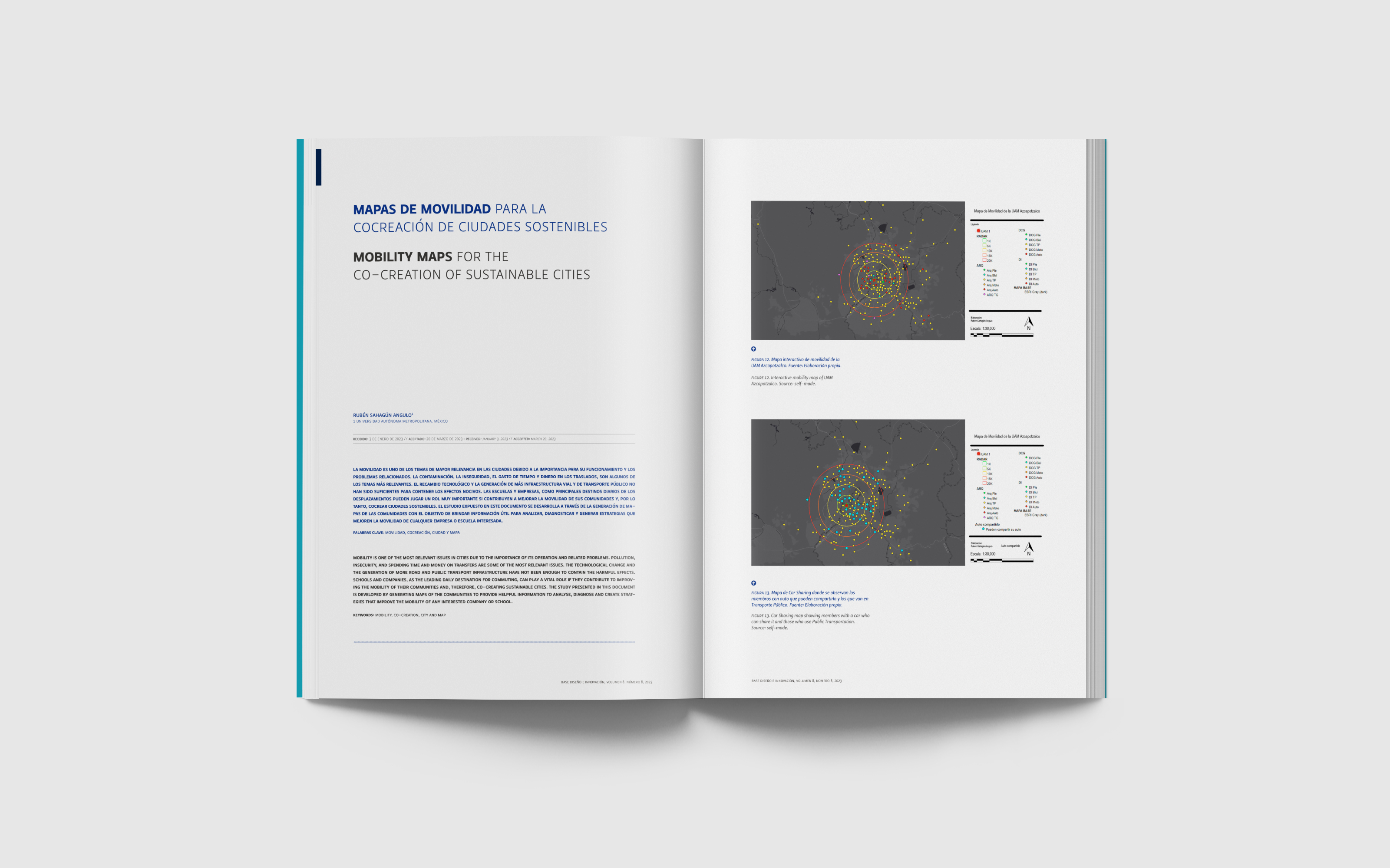Mobility maps for the co-creation of sustainable cities
Main Article Content
Abstract
Mobility is one of the most relevant issues in cities due to the importance of its operation and related problems. Pollution, insecurity, and spending time and money on transfers are some of the most relevant issues. The technological change and the generation of more road and public transport infrastructure have not been enough to contain the harmful effects. Schools and companies, as the leading daily destination for commuting, can play a vital role if they contribute to improving the mobility of their communities and, therefore, co-creating sustainable cities. The study presented in this document is developed by generating maps of the communities to provide helpful information to analyse, diagnose and create strategies that improve the mobility of any interested company or school.
Article Details
References
Bharadwaj, S., Ballare, S., & Chandel, M. K. (2017). Impact of congestion on greenhouse gas emissions for road transport in Mumbai metropolitan region. Transportation Research Procedia, 25, 3538-3551. https://doi.org/10.1016/j.trpro.2017.05.282
Bloomberg Línea (2022, marzo 23). CEO de Toyota en Latam: Región “no está preparada” aún para vehículos eléctricos. https://www.bloomberglinea.com/2022/03/23/ceo-de-toyota-en-latam-region-no-esta-preparada-aun-para-vehiculos-electricos/
Brown, A. (2017). Car-less or car-free? Socioeconomic and mobility differences among zero-car households. Transport Policy, 60, 152-159. https://doi.org/10.1016/j.tranpol.2017.09.016
Dai, Y., Li, X., Wang, D., & Wang, Y. (2022). Impact of Accessibility to Cities at Multiple Administrative Levels on Soil Conservation: A Case Study of Hunan Province. International Journal of Environmental Research and Public Health, 19(18), 11768. https://doi.org/10.3390/ijerph191811768
Ferrer, A. L. C., Thomé, A. M. T., & Scavarda, A. J. (2018). Sustainable urban infrastructure: a review. Resources, Conservation and Recycling, 128, 360-372. https://doi.org/10.1016/j.resconrec.2016.07.017
Ind, N., Fuller, C., & Trevail, C. (2012). Brand together: How co-creation generates innovation and re-energizes brands. Kogan Page Publishers.
Instituto de Diversificación y Ahorro Energético, IDAE. (2019). Planes de Transporte al Trabajo. Muévete con un plan. https://www.idae.es/sites/default/files/documentos/publicaciones_idae/guia-idae-019_ptt.pdf
Instituto Nacional de Ecología y Cambio Climático, INECC. (2018). Informe Nacional de Calidad del Aire, 2017, México. Coordinación General de Contaminación y Salud Ambiental, Dirección de Investigación de Calidad del Aire y Contaminantes Climáticos. Ciudad de México.
Instituto Nacional de Estadística y Geografía, INEGI. (2017) Encuesta Origen Destino en Hogares de la Zona Metropolitana del Valle de México (EOD) 2017. https://www.inegi.org.mx/contenidos/programas/eod/2017/doc/resultados_eod_2017.pdf
Irwin, T. (2011). Design for a Sustainable Future. In S. G. McNall, J. C. Hershauer, & G. Basile (Eds.), The Business of Sustainability: Trends, Policies, Practices and Stories of Success, Vol. II, pp. 41-60. Praeger.
Irwin, T. (2015). Transition Design: A Proposal for a New Area of Design Practice, Study and Research. Design and Culture, 7(2), 229-246. https://doi.org/10.1080/17547075.2015.1051829
Koglin, T., & Rye, T. (2014). The marginalisation of bicycling in Modernist urban transport planning. Journal of Transport & Health, 1(4), 214-222. https://doi.org/10.1016/j.jth.2014.09.006
Leadbeater, C. (2008). We Think: mass innovation not mass production. Profile Books.
Lefebvre, H. (1991). The production of space. Blackwell. (Original book published 1974).
Mattioli, G., Roberts, C., Steinberger, J. K., & Brown, A. (2020). The political economy of car dependence: a systems of provision approach. Energy Research & Social Science, 66, 101486. https://doi.org/10.1016/j.erss.2020.101486
Milenio. (2020, enero 24). Se satura Línea 7 del Metro; reportan retrasos de hasta una hora. https://www.milenio.com/politica/comunidad/metro-cdmx-caos-linea-7-metro
Moreno, C. (2019). The 15 min-city: for a new chrono-urbanism! - Pr Carlos Moreno. Recuperado desde https://www.moreno-web.net/the-15-minutes-city-for-a-new-chrono-urbanism-pr-carlos-moreno/
Organización Mundial de la Salud, OMS. (2015). Resolución WHA68.8. Salud y medio ambiente: impacto sanitario de la contaminación del aire. In 68.ª Asamblea Mundial de la Salud, Ginebra, 18–26 de mayo de 2015. Resoluciones y decisiones (pp. 19-26).
Proceso. (2021, mayo 3). Colapsa estructura del Metro y cae tren con pasajeros en la Línea 12. https://www.proceso.com.mx/nacional/2021/5/3/colapsa-estructura-del-metro-cae-tren-con-pasajeros-en-la-linea-12-hay-20-muertos-70-heridos-263206.html
Sabatini, F. (2006). La segregación social del espacio en las ciudades de América Latina. Banco Interamericano de Desarrollo, Departamento de Desarrollo Sostenible, División de Programas Sociales.
Salinas, L. (2008). Segregación residencial en la Zona Metropolitana de la Ciudad de México: diez años de cambios en el mundo, en la geografía y en las ciencias sociales, 1999-2008. Universidad Autónoma de México.
Secretaría del Medio Ambiente de la Ciudad de México. (2018). Inventario de Emisiones de la Ciudad de México 2016. Dirección General de Gestión de la Calidad del Aire, Dirección de Programas de Calidad del Aire e Inventario de Emisiones. http://www.aire.cdmx.gob.mx/descargas/publicaciones/flippingbook/inventario-emisiones-2016/mobile/inventario-emisiones-2016.pdf
Schwanen, T. (2016). Geographies of transport I: reinventing a field? Progress in Human Geography, 40(1), 126-137. https://doi.org/10.1177/0309132514565725Ramaswamy, V., & Gouillart, F. J. (2010). The Power of Co-Creation: build it with them to boostgrowth, productivity, and profits. Simon and Schuster.
Ritchie, H. & Roser, M. (2017) Air Pollution. OurWorldInData.org. Retrieved from: https://ourworldindata.org/air-pollution
Ritchie, H., Spooner, F., & Roser, M. (2018). Causes of death. OurWorldInData.org. Retrieved from: https://ourworldindata.org/causes-of-death
Ritchie, H. & Roser, M. (2019) Outdoor Air Pollution. OurWorldInData.org. Retrieved from: https://ourworldindata.org/outdoor-air-pollution.
World Bank & Institute for Health Metrics and Evaluation, IHME. (2016). The Cost of Air Pollution: Strengthening the Economic Case for Action. World Bank. https://openknowledge.worldbank.org/entities/publication/cf3cfda2-6232-5f57-9979-dacb8aa5a302


